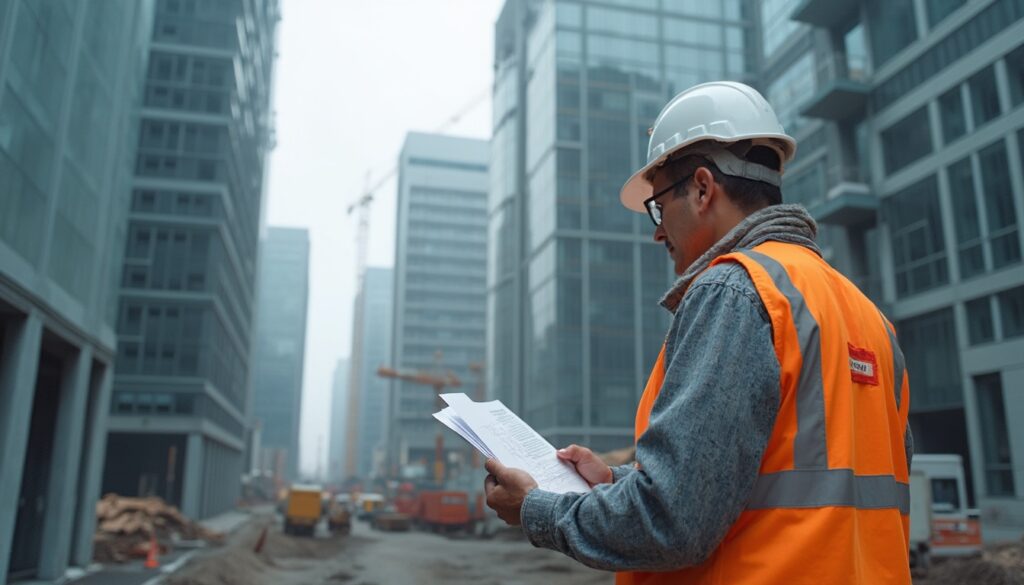What distinguishes modern structural engineering examples
Structural engineering encompasses all buildings constructed primarily above ground and forms the backbone of the German construction industry. Despite a tense economic situation, revenue in the main construction industry is expected to reach nearly 160 billion euros in 2024. Modern structural engineering examples such as the 176-meter-high Estrel Tower in Berlin or the new Roche Diagnostics research building show that today it’s about more than just height and area. They integrate complex technology, sustainable materials, and require coordination of dozens of trades with over 1,000 employees on a single construction site. This complexity poses enormous demands on project management and communication. The distinction from civil engineering, which deals with buildings at or below ground level, is clearly defined, as you can also read about in our article on structural engineering and civil engineering you can read more about it.
The successful realization of such projects largely depends on precise and comprehensive documentation that accompanies the entire construction process.
The biggest risks in structural engineering: Communication and documentation
The greatest hurdles in current structural engineering projects often lie not in the statics but in the organization. A study by Fraunhofer IESE on digitalization confirms that the industry primarily desires more efficient processes and better collaboration. However, the reality looks different: Structural engineering recently had to endure a real revenue decline of 12.2 percent, underscoring the tense situation. A major cost driver is defects and rework caused by communication errors. Information exchanged via unstructured channels like WhatsApp is not legally secure and gets lost in everyday operations. This leads to an error rate that can account for up to 10% of construction costs. Comprehensive documentation according to VOB/B, including a construction diary and measurements, is legally required but often becomes a burden.
Here are the most common problems resulting from this:
- Lack of legal security: Agreements in WhatsApp groups are hardly legally secure in case of disputes.
- High manual effort: Manually transferring photos and notes into construction day reports costs up to 5 hours per week for each site manager.
- Information silos: Important decisions often do not reach all stakeholders in time, leading to costly mistakes.
- Language barriers: In international teams, important details can be lost in translation amidst the daily hustle.
These inefficiencies jeopardize not only the margin but also adherence to schedules, which significantly influences the future of the construction industry. Digitalization that makes an impact in practice
Digitalisierung, die in der Praxis ankommt
The construction industry has recognized the need for digitalization, but implementation often fails due to complexity. A study on digitalization in construction shows that many software solutions fail due to a lack of interoperability and the high effort required for training. While Building Information Modeling (BIM) is valuable in the planning phase, there’s a lack of simple tools for construction execution – the phase where most errors occur. Less than 30% of the on-site employees actively use complex construction software. The acceptance of new apps that require intensive training is low. This is exactly where Valoon comes in. Instead of introducing a new app, we utilize the channel that 100% of your employees on-site already use: WhatsApp.
Valoon transforms everyday communication into structured, legally secure data without requiring your team to change their behavior. This lowers the entry barrier to zero and ensures that digitalization truly reaches the construction site and doesn’t just take place in the office.
Here’s how legally secure documentation via WhatsApp works
Imagine an employee discovers a defect on the construction site. The traditional process of making calls and dealing with confusing chats is slow and error-prone. With Valoon, this process is documented securely and understandably within seconds.
The process is remarkably simple:
- Send a photo or voice message: The employee sends a photo of the defect, a note, or a voice message to a Valoon WhatsApp chat as usual.
- Automatic capture: Valoon analyzes the message, automatically assigns it to the correct construction project, and captures all relevant data such as timestamp, location, and sender.
- Structured filing: The information becomes immediately visible as an entry in the digital construction diary in the Valoon web portal for the office – including weather data.
- Task and defect management: In the office, the site manager can convert the report into a task with just one click, assign it to a trade, and set a deadline.
This automated process reduces documentation effort by up to 75% and creates a seamless chain of evidence. Simple messages turn into legally secure facts that support you during handovers and in case of disputes. This efficiency is crucial for the success of successful large projects..
Your advantage with Valoon: Simplicity, efficiency, and legal security
Valoon was designed to eliminate the biggest weaknesses in structural engineering. We translate chaotic construction site communication into structured and legally secure documentation. Your team on-site works as usual with WhatsApp – without training, without a new app. In the office, you receive all information in real-time, perfectly prepared for construction day reports, defect tracking, and measurements. Our customers report time savings of up to 5 hours per week per site manager.
Benefit from Simplicity, because your employees do not need to learn new software. Increase your Efficiency through automated processes and avoid costly mistakes. Gain Legal security with seamless documentation that meets the requirements of VOB/B at all times. Focus back on what matters: creating top-notch structural engineering examples . Book your free demo now and find out how Valoon revolutionizes communication on your construction site in just 15 minutes.
More Links
de.digital provides a comprehensive overview of the state of digitalization in Germany.
Fraunhofer IESE provides a blog article on a study regarding digitalization in the construction industry.
Das Federal Statistical Office (Destatis) illuminates the potential of digitalization in construction activity statistics.
PwC presents a study on the construction industry in 2023, analyzing the state of digitalization and sustainability.
Der Central Association of the German Construction Industry (ZDB) presents its positions on digitalization.
Das Federal Ministry of Transport and Digital Infrastructure (BMV) provides information on Building Information Modeling (BIM).
BIM Germany is the central platform for Building Information Modeling in Germany.
Die Chamber of Architects Baden-Württemberg provides a BIM guideline for Germany.
FAQ
Does Valoon also work without internet on the construction site?
Yes, WhatsApp messages are sent as soon as an internet connection is re-established. Valoon processes the data automatically with the correct timestamp of the capture time, ensuring no information is lost.
Is communication through Valoon and WhatsApp GDPR compliant?
Yes, Valoon ensures GDPR compliance. Data is processed and stored on German servers. By using a dedicated business number and structured processing in the Valoon portal, data protection requirements are fulfilled.
What does Valoon cost for employees on the construction site?
For employees on the construction site, using Valoon via WhatsApp is completely free of charge. Costs only apply to the licenses for office staff using the web portal for managing and evaluating data.
What languages does the live translation support?
Valoon can live translate voice messages and texts in over 30 languages. This helps break down language barriers on international construction sites and increases safety and efficiency.
How quickly can Valoon be implemented in the company?
The implementation of Valoon usually takes less than a day. Since no software installation or training for the on-site teams is required, the system can be used immediately after setting up the projects in the web portal.
Can I integrate Valoon into my existing software?
Yes, Valoon is designed to act as a bridge between the construction site and the office. We offer interfaces to common construction software solutions to ensure a smooth data flow and prevent silo solutions.








